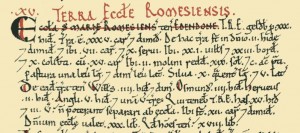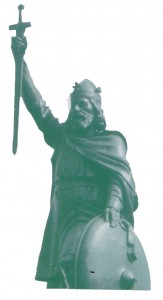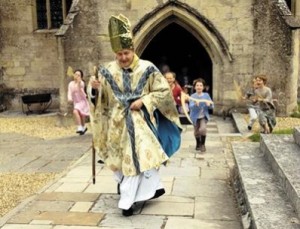A Brief History of Edington
Edington is a picturesque and historic spring line settlement that lies under the dramatic escarpment of Salisbury Plain. With its origins preceding the Dark Ages it holds an honourable place in the history of Wessex for it was here that most people believe that King Alfred defeated the Danes
The Battle of Ethandun in 878 AD on the hills above Edington, at which King Alfred the Great defeated the Danes led by Guthrum was a turning point for Englishmen after the Danes had believed themselves to be conquerors of Wessex by the winter of 877AD. It is popularly believed that Edington takes its name from this battle, and that a horse was carved into the chalk hillside to celebrate the great victory. This horse was overlaid and destroyed by one cut in 1778 and is now known as ‘The Westbury White Horse’.  The Witan, an Anglo Saxon advisory council to the King, met at Edington in 957. The Manor of Edington, left by Alfred to his wife, Ealhswith, was granted to a house of Benedictine nuns at Romsey Abbey in Hampshire in 968 by King Edgar and this is recorded in the Domesday Survey of 1086. The parish was part of the hundred of Whorwellsdown.
The Witan, an Anglo Saxon advisory council to the King, met at Edington in 957. The Manor of Edington, left by Alfred to his wife, Ealhswith, was granted to a house of Benedictine nuns at Romsey Abbey in Hampshire in 968 by King Edgar and this is recorded in the Domesday Survey of 1086. The parish was part of the hundred of Whorwellsdown.
The medieval period was significant to Edington as in 1351, William of Edington, Bishop of Winchester and Chancellor of England, who was a younger son of a leading family of the village, founded a college of chantry priests in Edington. This was soon converted into a monastic house of the Augustinian order of Bonshommes. By order of the Bishop, the Church of St Mary, St Katharine and All Saints was built, and consecrated in 1361. Edington lies on an old pilgrims route between Bath and Salisbury so was a natural place for the Bonshommes order of monks to establish a large priory that thrived until the dissolution of the monasteries in 1539 by King Henry VIII. Only the walls of the monastery and the splendid Priory Church remain.
A less pleasant claim to fame occurred in 1450 when, during Cade’s rebellion, the Bishop of Salisbury, William Aiscough, was seized while celebrating mass, by an angry mob. He was taken to the top of Edington Hill where he was stoned to death. Bishop Aiscough was a favourite of the King. as he had married Henry VI and the deeply unpopular Margaret of Anjou.
Once considered to be a separate village, Tinhead lies to the east of Edington. It’s name is thought to be derived from ‘ten hides’ and like Baynton and West Coulston was a separate tithing within the Parish of Edington. Further details on the history of Edington can be found here..
Today the village has no obvious centre and is spread out around a network of small roads, characterised by attractive houses and cottages, some of them half timbered and thatched. The old turnpike road from Bath to Salisbury ran through Tinhead and in the 18th century The George Inn (now Mulberry House) was a coaching inn. The turnpike can be followed climbing the hillside as a track on to the top of Coulston Hill and then on to Gore Cross via the Salisbury Plain perimeter road. Two milestones still giving the distance to Bath and Salisbury from this remote place remind us of straining teams of horses pulling heavy coaches up the rutted chalk trackway.
To the north of Edington lies Keevil aerodrome which played a major role in World War II, especially the Normandy Landings ( Operation Overlord), dropping 806 paratroopers of the 6th airborne division near Caen as well as ‘Operation Market Garden’.where 48 gliders delivered the British element of a multi-national force tasked with securing the bridges over the lower Rhine.
Salisbury Plain’s Ghost Village of Imber lies to the south. On 1st November 1943, the inhabitants were informed by the war office that they had six weeks to prepare for evacuation. The village was required to help prepare the American army for the imminent invasion of Europe. Villagers always believed that they would be allowed back after the Second World War but it seems that Imber is too important a training ground and in 1961, the Crown closed off all rights of way. Today, at certain times of the year, some of the roads to Imber are open to the public and each year on the first Saturday in September usually a service is conducted in the Church of St Giles. The story of Imber can be read in the book ‘Little Imber on the Down’ by Rex Sawyer.
Further historical information about the village can be found here..


